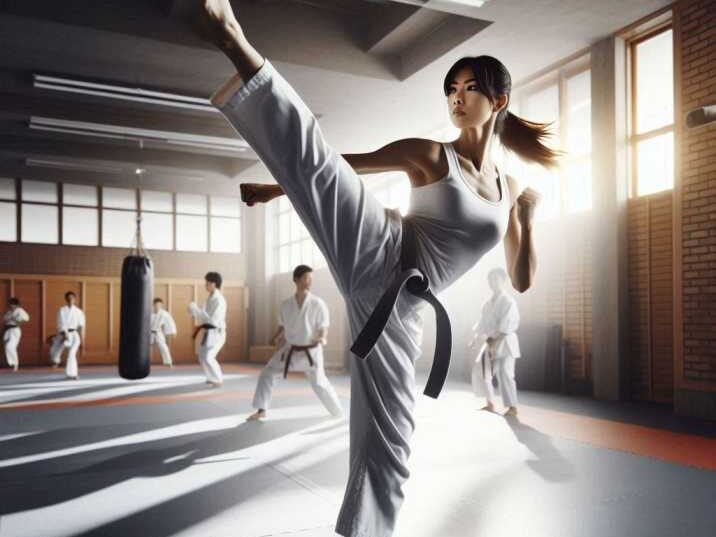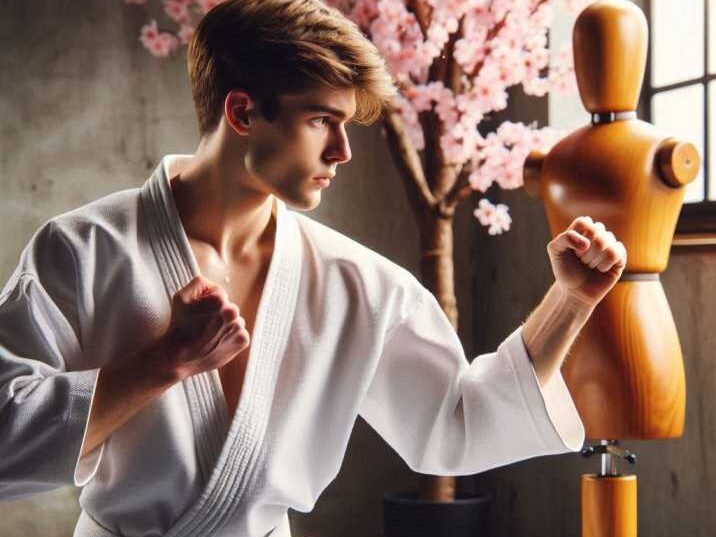Introduction
Table of Contents
Have you ever wondered what martial arts are best for self-defense? Imagine walking down the street, feeling confident that you can protect yourself if needed. That’s the power of learning martial arts. From Karate to Brazilian Jiu-Jitsu, there are many types of martial arts that teach you how to defend yourself. In this article, we’ll explore some of the most popular martial arts used for self-defense. Whether you’re a kid or an adult, these martial arts can help you stay safe, strong, and confident.
10 Types of Martial Arts for Self-Defense
1. Karate
Karate is one of the most famous martial arts in the world. Originating from Okinawa, Japan, Karate focuses on powerful punches, kicks, and blocks. It teaches students how to defend themselves by striking an attacker with speed and accuracy. Karate is great for building discipline, confidence, and physical fitness.

1.1 Key Techniques in Karate
- Punches: Straight punches, uppercuts, and hooks are common.
- Kicks: High kicks, low kicks, and sidekicks.
- Blocks: Using hands and arms to block an opponent’s attack.
2. Taekwondo
Taekwondo comes from Korea and is known for its high, fast kicks. If you’ve ever watched the Olympics, you might have seen Taekwondo matches. This martial art emphasizes flexibility, balance, and speed, making it perfect for self-defense situations where you need to act quickly.
2.1 Why Taekwondo is Effective for Self-Defense
- Kicking Techniques: Taekwondo kicks can keep an attacker at a distance.
- Self-Control: Taekwondo teaches students to control their body and mind.
- Speed: Quick movements can surprise and overpower an attacker.
3. Brazilian Jiu-Jitsu
Brazilian Jiu-Jitsu (BJJ) is a ground-fighting martial art that focuses on grappling and submission holds. It’s often called the “gentle art” because it allows a smaller person to defend themselves against a larger opponent by using leverage and technique rather than strength.
3.1 BJJ’s Unique Approach to Self-Defense
- Grappling: Controlling an opponent on the ground.
- Submissions: Applying joint locks and chokeholds to neutralize a threat.
- Escapes: Techniques to escape from dangerous positions.
4. Judo
Judo is another martial art from Japan that emphasizes throws and grappling. Instead of striking, Judo teaches you how to use your opponent’s strength against them. By mastering balance and timing, you can throw an attacker to the ground and control them without causing serious harm.
4.1 Judo Techniques for Defense
- Throws: Using an attacker’s momentum to flip them over.
- Pins: Holding an opponent down on the ground.
- Submissions: Using arm locks and chokeholds.
5. Krav Maga
Krav Maga is a martial art developed by the Israeli military. It’s known for being highly practical and focused on real-life self-defense situations. Krav Maga combines techniques from various martial arts, including boxing, wrestling, and judo, to create a system that is easy to learn and effective.
5.1 Real-World Self-Defense with Krav Maga
- Disarming Attacks: Techniques to take away weapons from attackers.
- Quick Strikes: Aiming for vulnerable areas like the eyes and groin.
- Situational Awareness: Learning to avoid danger before it happens.
6. Muay Thai
Muay Thai, also known as “Thai boxing,” is a martial art from Thailand. It’s often referred to as the “art of eight limbs” because it uses punches, kicks, elbows, and knees. Muay Thai is excellent for self-defense because it teaches you how to use your entire body as a weapon.
6.1 How Muay Thai Keeps You Safe
- Striking Power: Strong punches and kicks to fend off attackers.
- Clinching: Controlling an opponent’s movement by holding them close.
- Conditioning: Building endurance and strength to stay safe.
7. Aikido
Aikido is a Japanese martial art that focuses on harmony and non-violent self-defense. Instead of meeting force with force, Aikido practitioners use the attacker’s energy against them. This martial art is perfect for those who want to defend themselves without causing injury.
7.1 The Philosophy of Aikido in Defense
- Redirecting Force: Moving with the attacker’s motion to throw them off balance.
- Joint Locks: Controlling an opponent by locking their joints.
- Peaceful Resolution: Aikido teaches defense without aggression.
8. Wing Chun
Wing Chun is a Chinese martial art that focuses on close-range combat. It was made famous by Bruce Lee, who studied it before developing his own martial art. Wing Chun uses quick punches and low kicks to neutralize an attacker before they have a chance to react.
8.1 Wing Chun for Close-Range Defense
- Chain Punches: Fast, repeated punches to overwhelm an opponent.
- Centerline Theory: Protecting your body’s central line while attacking.
- Simplicity: Wing Chun uses simple, direct movements that are easy to learn.
9. Boxing
Boxing might seem like just a sport, but it’s also a great martial art for self-defense. Boxing teaches you how to use your fists effectively, defend against punches, and improve your footwork. It’s a highly effective way to protect yourself in a confrontation.
9.1 The Self-Defense Benefits of Boxing
- Punching Skills: Powerful punches to defend yourself.
- Defense: Learning how to dodge and block attacks.
- Stamina: Building the endurance needed in a fight.
10. Jeet Kune Do
Jeet Kune Do was developed by Bruce Lee as a philosophy of martial arts rather than a strict style. It’s all about simplicity, directness, and freedom. Jeet Kune Do encourages you to take what works from different martial arts and use it in real-life situations.

10.1 Why Jeet Kune Do Stands Out
- Adaptability: Using any technique that works in the moment.
- Efficiency: Striking quickly and with purpose.
- No Limitations: Jeet Kune Do is about personal expression in martial arts.
Table of Information: Types of Martial Arts for Self-Defense
| Martial Art | Origin | Focus | Key Techniques |
|---|---|---|---|
| Karate | Japan | Striking | Punches, kicks, blocks |
| Taekwondo | Korea | Kicking | High kicks, speed, flexibility |
| Brazilian Jiu-Jitsu | Brazil | Grappling | Submissions, ground control |
| Judo | Japan | Throws | Throws, pins, submissions |
| Krav Maga | Israel | Real-World Defense | Disarms, quick strikes, awareness |
| Muay Thai | Thailand | Striking | Punches, kicks, elbows, knees |
| Aikido | Japan | Harmony | Redirecting force, joint locks |
| Wing Chun | China | Close-Range Combat | Chain punches, centerline theory |
| Boxing | Various | Striking | Punching, defense, footwork |
| Jeet Kune Do | USA (Bruce Lee) | Adaptability | Efficiency, directness, freedom |
Conclusion
Learning martial arts for self-defense is not just about protecting yourself; it’s about gaining confidence, improving your fitness, and learning discipline. From the striking power of Karate and Muay Thai to the grappling techniques of Brazilian Jiu-Jitsu and Judo, each martial art offers unique ways to defend yourself. Whether you’re a kid or an adult, there’s a martial art out there for you. So why wait? Start your journey in martial arts today and become your own best defender!
FAQs
1. What is the best martial art for beginners in self-defense?
Karate and Taekwondo are great for beginners because they are widely available and easy to learn.
2. Can martial arts help in real-life situations?
Yes, martial arts like Krav Maga and Brazilian Jiu-Jitsu are specifically designed for real-world self-defense.
3. Is it possible to learn martial arts at home?
While it’s best to learn with an instructor, you can start with basic techniques at home using online resources.
4. Which martial art is the safest to learn?
Aikido is one of the safest martial arts, as it focuses on non-violent self-defense techniques.
5. How long does it take to learn self-defense through martial arts?
It varies, but with consistent practice, you can learn basic self-defense techniques in about six months to a year.


